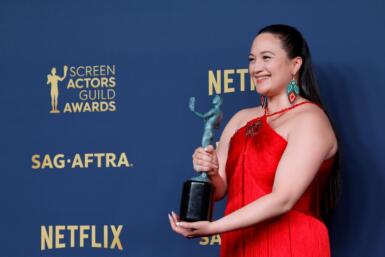Lenoir’s research lab studies how pop culture and entertainment reflect society

Media School assistant professor Lisa Lenoir’s research lab, which began this academic year, has been conducting trend studies on pop culture and entertainment news such as the Super Bowl, Grammys, Taylor Swift, and the upcoming Academy Awards. The undergraduate students in her lab helping conduct research are a part of the Center of Excellence for Women in Technology and former students in Lenoir’s Media, Fashion & Politics course.
One of Lenoir’s goals for this research lab is to legitimize the fairly new discipline of fashion communication research and facilitate deeper conversations on the role of trends in this area. Researching and studying popular culture and entertainment can reveal much more about society than people realize.
“I think pop culture, celebrity culture, and award shows are just like a microcosm of what’s going on in society on a larger scale,” said Imani Hawkins, a senior majoring in fashion media.
“I just really like pop culture because I feel like it bleeds into so many other fields,” said Natalie Cartmel, a sophomore majoring in media advertising with a concentration in creative technologies & art and design. “With the whole Taylor Swift thing, we’ve discovered that not only is Taylor Swift involved in celebrity and music, but also fashion, relationships, and sports. We get to see how the media plays out with that.”

“I think pop culture and fashion and celebrities, and even if we’re talking about entertainment media as opposed to traditional news sources, research on pop culture is often delegitimized and belittled,” said Grace Romine, a sophomore majoring in journalism with a concentration in news reporting and editing and a minor in human-centered computing. “People don’t think it has this large effect on society that we’re talking about.”
All three students have been doing trend research on the coverage of Taylor Swift in media outlets such as The New York Times and People Magazine. They have observed how different audiences interact with Taylor Swift.
“I think that the obsession with Taylor Swift and celebrity culture in People Magazine, especially since they only covered positive things about her, I feel like since people see themselves in celebrities, it’s kind of a way of escapism,” said Hawkins.
Not only are we seeing popular and celebrity culture intersect with fields such as fashion or athletics, but also with politics. While it may seem like modern celebrities are more involved in politics, historically this is not uncommon.
“We saw this during the Civil Rights Movement with actors such as Harry Belafonte, Sidney Poitier, Aretha Franklin. While they may have not always been front-facing, actually saying and making political statements, they may have been contributing economically,” said Lenoir.
Belafonte, Poitier, and Franklin all were able to advocate for racial equality and break down barriers through their art. However, many celebrities who engaged in activism had to be careful about how they expressed their political opinions because it could be detrimental to their careers.
“I think what we’re seeing now is that celebrities are making their own brand decisions, and they’ve become much more individualistic in terms of what they can and cannot do. I think they know the collateral damage of participating in political movements,” said Lenoir.

Along with examining the intersections of pop culture and politics, the lab has also been exploring the upcoming Academy Awards through their research. Lenoir has previously covered the Academy Awards as a journalist at The Chicago Sun-Times. This year’s Academy Awards are particularly noteworthy because of Lily Gladstone’s historic nomination as the first Native American to be nominated for Best Actress for their role in “Killers of the Flower Moon,” and the social media discourse surrounding “Barbie.” The controversy surrounding Greta Gerwig and Margot Robbie not being nominated for Best Director and Best Actress, despite the film being nominated for Best Picture, quickly became the dominant story in Oscar’s coverage. This ultimately led to the strides in representation for Native American people made by Gladstone to be overshadowed in the media.

“What we also talk about is this idea of a dominant narrative and how these dominant narratives, in which our social world is organized, can sometimes overshadow the historically marginalized,” said Lenoir.
Lenoir and her students have also been focusing on and observing how the Academy Awards have a significant influence on trends in the fashion industry. The award ceremony has become a space for designers to show off their collections on the red carpet, which can often reflect the state of the market.
When reflecting on the importance of studying entertainment events like the Academy Awards, Lenoir expressed that, “It’s part of what makes the United States the United States, that we do have these different industries by which we engage in, and entertainment is something that has been really at the core of the American experience.”

